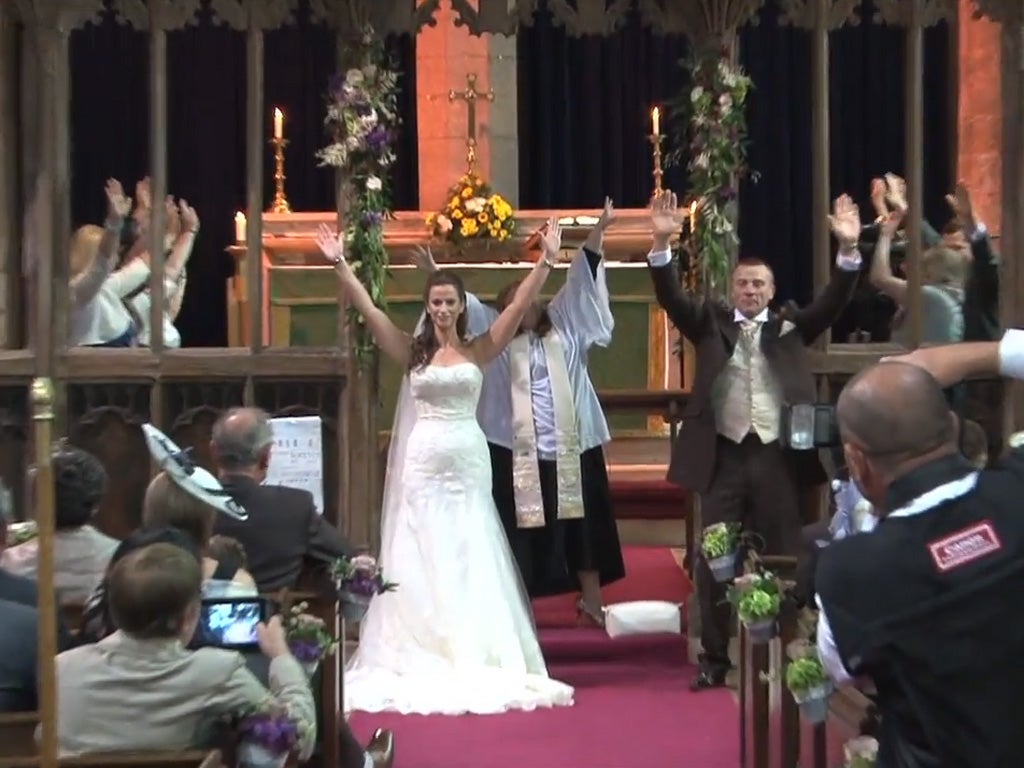The 'viral vicar' who led wedding dance flash-mob is a great example of how to make religion interactive
Most activity in Church takes place from the front, like an old-school classroom. Isn't it time we mixed things up to embrace spirituality?

Church is usually assumed to be a dull place and attended like the dentist's surgery; only when utterly necessary and for as short a duration as possible. Thankfully there are no drills at church but for many people the rituals, hymns and collection plate can loom as ominously as a root canal.
The viral video of Reverend Kate Bottley, a young and energetic vicar from Nottingham, set the social media world alight for exactly this reason; a wedding ceremony attended by people unaccustomed to church or religion was suddenly punctuated by a surprise flash-mob. Kate and the couple unexpectedly broke into a choreographed dance, followed by more of more members of the congregation. Something about it captured people's hearts; perhaps it was the joy, perhaps the echoes of Sister Act, but for whatever reason the video has snowballed across social, print and TV media.
It made me reflect on the summer solstice, attended by over twenty one thousand people, at Stonehenge last week. We live in a post-Christian nation, yet spirituality is still very much alive and kicking. People flocked to the pagan stones in search of a transcendent experience, with most describing themselves as 'spiritual but not religious'. This huge solstice attendance brings many questions to the doors of established religion. The latest Church of England attendance figures teeter between stabilisation and continued decline. So why aren't these twenty one thousand spiritual seekers beating down the doors of their local parish church instead of driving to Stonehenge for their spiritual kicks?
My hunch is that it has a lot to do with the style of church gatherings. In this digital age, participation has become our natural way of life; the internet has moved from "1.0" to "2.0" and the formerly passive experiences of reading a static webpage of text has exploded into a multi-directional, fluid exchange of views and user-generated content. We don't just consume or passively receive information any more; we comment back, we contribute, we change things. We aren't just receivers; we are shapers of the digital environments we inhabit.
Yet in Church, besides reading words from a sheet or screen and saying hello at a set time of socialising, most activity takes place from the front, led by one or two people. The style is that of an old-school classroom, with seats or butt-numbing-pews facing the leader who stands at a podium. Even schools have (for the most part) abandoned this old classroom model in favour of something with a far more interactive seating plan, so this set up is increasingly alien to a new generation.
Looking at the thousands worshipping at Stonehenge, it was a far more open, collaborative approach to spirituality; way less old-school-classroom and much more "2.0". Colour, energy, creativity and celebration are words that sum up many of the images of the worshippers gathered around those vast stones. Not terms we often associate with solemn religious practice in church.
The great thing about the wedding flash mob and Rev Kate Bottley's courage in leading it, was that suddenly the whole room was swept up into something participatory. They were jolted out of the boredom that can set in during church. It stopped them from texting or playing Angry Birds under the pews and the element of joy, surprise and energy drew them in. They became participating shapers of the experience, not just semi-passive recipients.
So perhaps the model of worship services is something the church can re-imagine. Some are doing this already; the Fresh Expressions movement, for example. But the majority of churches of a Sunday deliver a front-led, classroom style experience that may need some imagination and creativity. I wonder what "church 2.0" would look like, where leadership is more open-handed and every attendee shapes the experience and collaborates. Scary for the leadership as it means relinquishing much control. But if this could become reality, might it bring the Stonehenge spiritual seekers into the doors?
One thing is for sure - Rev Kate Bottley gives us hope that it's possible to snap a congregation out of their boredom by showing them spirituality doesn't always need to be solemn. It can be vibrant, creative and full of surprises. If the pews are going to have anyone left in them in fifty years, we need more like her; perhaps, I hope, we've just witnessed a female bishop in the making.

Join our commenting forum
Join thought-provoking conversations, follow other Independent readers and see their replies